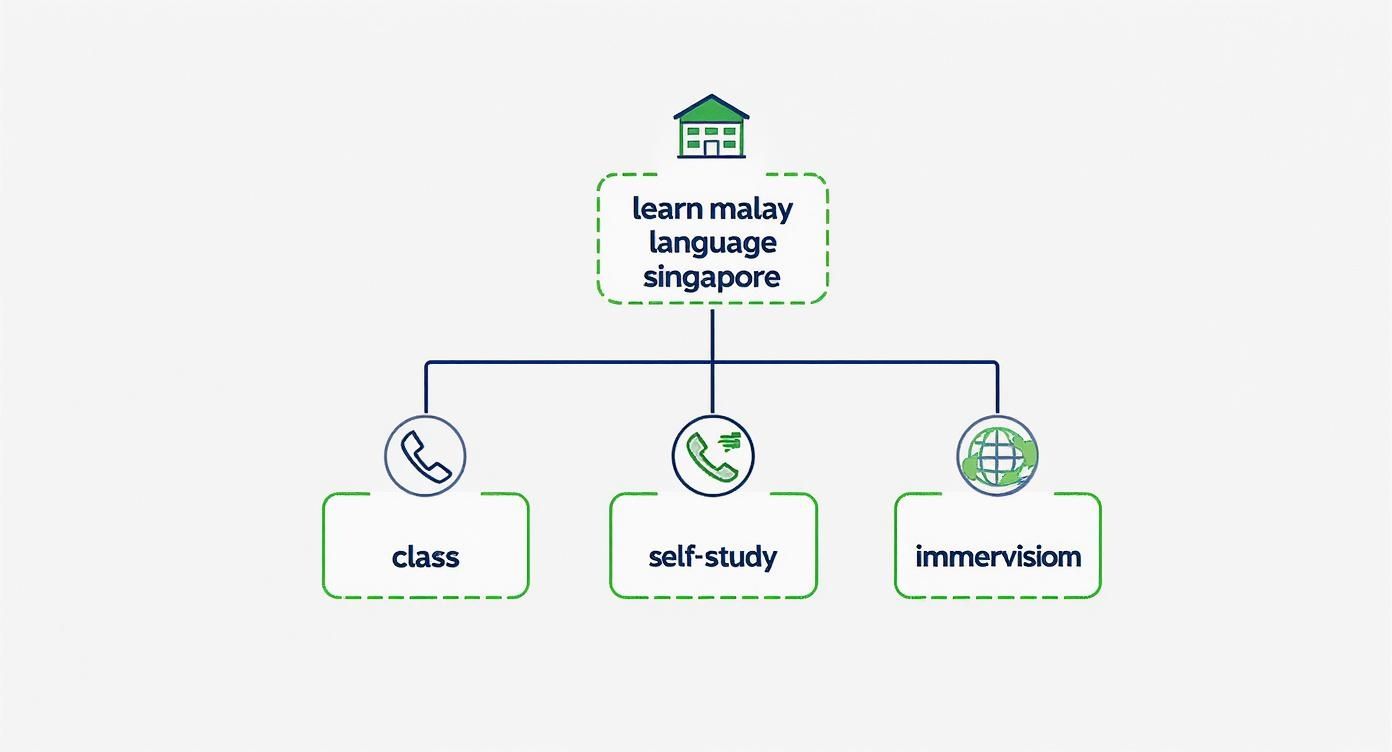learn malay language singapore: Quick Guide to Fluency
Learning Malay in Singapore starts with a plan that slots neatly into a hectic week. Combine structured lessons, handy apps and local meetups, and you’ll hit conversational goals faster than you think. Many learners reach basic fluency in just one month by following a blend of these strategies.
Getting Started With Learning Malay In Singapore
First, pinpoint why you’re learning. Are you aiming for casual chats at kopitiams or a formal certification? The path you choose should align with your ultimate goal.
Consider Priya, a banker who attends weekend group classes and squeezes in five-minute drills on her phone each morning. On the other hand, Aman winds down each evening with a quick vocab review before joining weekend language exchanges. These routines show how flexibility and consistent check-ins keep you on track.
- Classroom courses for steady progress and peer motivation
- Private tutoring for tailored feedback and adaptable scheduling
- Self-study with apps, podcasts and textbooks at your own pace
- Cultural immersion through community events, media and meetups
- Exam-focused prep using past papers and targeted exercises
Cultural trends also matter. Only 3% of children aged 5–14 speak Malay exclusively at home nowadays, while 57% primarily rely on English and 34% use Malay most of the time. For a deeper dive, check out this research on Malay language usage in Singapore.
Spotlight On Real Learners
Here’s a quick look at the Malay language family tree and its reach across Southeast Asia. It’s a reminder that your effort connects you with over 30 million speakers in the region.
Quick Learning Path Overview
Below is a snapshot of each main approach, highlighting time commitments, costs and the learners they suit best. Use it to decide which route fits your lifestyle and budget.
| Learning Path | Description | Estimated Time | Cost | Best For |
|---|---|---|---|---|
| Classroom courses | Group classes at language centres | 8–12 weeks | $300–$600 | Consistent schedule |
| Private tutoring | One-on-one sessions with certified tutors | 1–2 sessions/week | $30–$80/hour | Personalised feedback |
| Self-study | Apps, podcasts, textbooks and online resources | 3–6 months | Free–$100 | Independent learners |
| Cultural immersion | Meetups, events, media in Malay | Ongoing | Varies (low) | Experiential learners |
| Exam-focused prep | Past papers and targeted revision | 3–4 months | $100–$200 | Certification seekers |
Choose the approach that resonates with your daily routine and budget. Mix and match if you need extra support or variety.
Key Advantages Of Each Path
- Classroom Courses fuel momentum through regular lessons and group accountability.
- Private Tutoring zooms in on your weak spots with dedicated one-on-one time.
- Self-Study keeps costs low and fits neatly around unpredictable workweeks.
- Cultural Immersion boosts natural fluency by putting you in real Malay-speaking environments.
- Exam-Focused Prep hones exam techniques, sharpens timing and builds confidence under pressure.
For busy Singaporeans, pairing structured lessons with cultural immersion is often the fastest way to speak Malay confidently.
Now that you’ve got this roadmap, dive into the detailed options for classes, tutors and self-study. Start applying these insights today and watch your Malay improve week by week.
Choosing The Right Class Or Tutor
Picking the ideal learning format can make or break your Malay journey. In Singapore’s lively language scene, you’ll find local centres, private tutors and online courses vying for your attention.
Consider these factors before you decide:
- Teaching Method: Does the style match your ways of learning—visual, auditory or hands-on?
- Class Size: Small groups mean more speaking practice and personalised feedback.
- Accreditation: Certified tutors often bring exam-focused expertise, especially for HMTM or PSLE.
- Schedule Flexibility: Busy professionals and students need slots that fit around work or school.
Key Takeaway Small groups often boost confidence, while one-on-one sessions deliver targeted support.
Comparison Of Class Options And Tutoring
To help you weigh each choice quickly, here’s a snapshot of three popular paths in Singapore. Review features, pricing and drawbacks side by side.
| Option | Format | Price Range | Flexibility | Pros | Cons |
|---|---|---|---|---|---|
| Local Language Centres | In-person group | $200–$500/mo | Fixed schedule | Accredited curriculum and peer interaction | Less individual attention |
| Independent Tutors | One-on-one | $30–$80/hr | Custom hours | Personalised pace and exam focus | Higher hourly cost, variable quality |
| Digital Platforms | Online self-paced | $50–$150/term | High availability | Flexibility and multimedia content | Limited live feedback |
This comparison brings clarity to your budget, time and learning objectives.
Real-World Success Stories
Daniel, a marketing manager, swapped late-night self-study for evening small-group lessons. He noticed his speaking confidence skyrocket within six weeks.
Nur, still in secondary school, focused on intensive one-on-one sessions and secured top HMTM grades last year.
The uptake of HMTM rose from 5.7% of PSLE students in 2003 to 7.1% in 2012, and at 'O' Level from 8.3% to 10.7% over the same period.
Here’s a screenshot from the MOE website showing key enrollment figures for Malay language classes.
It highlights a steady rise in advanced Malay enrolment over the past decade.
Setting Clear Expectations
Before your first lesson, outline your fluency targets and exam dates. This ensures your tutor tailors each session.
- Confirm experience with PSLE or 'O' Level Malay exams.
- Request sample lesson plans or success stories from past students.
- Agree on preferred feedback channels—WhatsApp, email or in-class reviews.
Scheduling And Consistency
Pick times when you’re most alert—morning bursts or evening reviews. Then block those slots as non-negotiable appointments.
Consistency Over Intensity Wins Long-Term.
Free Trial And Rate Negotiation
Trial lessons are your risk-free window to assess teaching style. Don’t hesitate to:
- Commit to a 10-hour package in exchange for a 10% discount.
- Clarify refund policies for any last-minute conflicts.
Milestone Tracking
Biweekly check-ins help you see progress in real-time. Tie assessments to exam formats or everyday tasks, like ordering dinner in Malay.
- Use simple charts or mobile apps to map vocabulary growth.
- Celebrate each small win—master 200 new words or nail a speaking prompt.
Check out our detailed profiles of top centres in the Guide to Language Schools in Singapore.
Next Steps
After every lesson, jot down highlights and areas to refine. If progress plateaus, consider trying a different tutor or format.
Stay curious—ask for cultural notes, short stories or local podcasts. A fresh resource can reignite your enthusiasm.
Review your choice after one month and tweak your approach. Regular feedback from peers or mentors will keep you on track.
Daily commitment, honest reflection and the right support will set you up for sustainable Malay mastery.
Building A Self Study Routine
When your calendar is already packed, those 10- or 15-minute pockets of time become gold.
Squeezing Malay drills into your morning commute, lunch break or winding-down hour can turn scattered minutes into real progress.
Sample Weekly Schedule
To keep things varied and manageable, here’s a sample plan you might tweak:
- Mon–Fri Mornings (10 min): Review 15 flashcards on Anki
- Tue Lunch (20 min): Tune into Bahasa Kita podcast for fresh listening practice
- Wed Evenings (30 min): Write a short journal entry in Malay—notes on your day or reflections
- Thu Commute (15 min): Play back Malaysian news clips with subtitles
- Sat Afternoon (45 min): Role-play conversations with a language partner
- Sun Morning (1 hr): Assess weekly gains and quiz yourself on new vocabulary
Maya, who works in finance, swears by her 7 a.m. flashcard review and logs three fresh words during her 8 p.m. bus rides.
Meanwhile, Amir, a university student, uses Selamat Chat at lunch and saw his listening comprehension jump by 30% in just two weeks.
To deepen your understanding of spoken Malay from online clips, try transcription tools. Converting audio to text adds a layer of clarity to your vocabulary drills. YouTube to Text transcription services
Recommended Resources
- Quizlet for ready-made flashcard decks
- Bahasa Kita Podcast on Spotify, perfect for clear, conversational Malay
- Selamat Chat YouTube channel with real dialogues and cultural nuggets
- Clozemaster for context-driven sentence practice
- Malay News Today website, ideal for short articles and reading drills
Setting SMART Goals
SMART goals keep your sessions focussed and measurable.
Define what “specific” means—maybe 20 new words daily.
Make it “measurable” by aiming for 80% accuracy on your weekly quizzes.
Keep targets “attainable” in light of your schedule and energy levels.
Ensure goals are “relevant”—for instance, mastering café phrases before weekend coffee runs.
And always set a “time-bound” marker: finish a podcast without subtitles by week three.
| Goal Type | Metric | Tracking Tool |
|---|---|---|
| Vocabulary | 20 words per day | Anki flashcards |
| Listening | 80% comprehension | Podcast logs |
| Writing | 5 sentences daily | Online journal |
Small, consistent wins fuel motivation and build confidence.
Accountability Strategies
Pair up with a Malay study buddy and do quick weekly check-ins.
Share your charts in a simple spreadsheet or habit-tracker.
Run brief, 10-minute quizzes on Sunday evenings to lock in fresh words.
Check out our guide on online classes in Singapore for extra live practice.
Case Study – Priya and Her Study Journal
Priya, a marketing intern, tracks daily word counts and reflections in a bullet journal. She adds colourful stickers for each goal hit, proudly viewing a 30-day streak at month’s end.
Avoiding Burnout
Variety is your best friend here. Mix up formats to stay engaged:
- Change media types—alternate between news articles, podcasts and quick videos
- Take a micro-break every 30 minutes: stand, stretch or sip water
- Switch apps like Duolingo, Memrise and HelloTalk to keep context fresh
- Try themed weeks (food, travel or culture) for targeted vocabulary boosts
- Reward yourself when you master 100 words—a small treat goes a long way
Research shows educational achievement among Malay students in Singapore improved significantly over the past few decades, with the proportion achieving at least a 'C' grade in the 'O' Level exams rising by 22% between 1980 and 2004, reflecting increased support programs and targeted investments in Malay-majority schools. Learn more about these improvements
A routine that balances structure with flexibility will keep you moving forward, even when life gets hectic. Start today, track your wins and watch your Malay skills grow in under a month.
Immersing Yourself In Malay Culture
Malay culture is woven into daily routines across Singapore. From kopitiam chitchat to community performances, real-life interactions bring textbook phrases to life. Embracing these moments is key if you want to speak Malay with confidence.
You don’t need grand events to practise. Small rituals—greeting your barista in Malay or catching a local play—make a lasting difference.
- Look out for free Malay theatre nights at People’s Association centres.
- Subscribe to neighbourhood centre updates on Facebook or Instagram.
- Show up early and say “selamat malam” to performers in the lobby.
| Activity | Location | Frequency |
|---|---|---|
| Community Theatre | PA Halls | Monthly |
| Coffee Orders Practice | Hawker Centres | Daily |
| Language Exchanges | Geylang, Woodlands | Weekly |
| Podcast Sessions | Anywhere with headphones | Daily |
| Novel Reading | National Library Board | Biweekly |
| Cooking Workshops | Cultural Festivals | Seasonal |
Theatre And Performances
Malay theatre mixes dance, humour and timeless stories. Imagine settling into a row of chairs at Tampines Community Centre, notebook in hand, noting down funny one-liners and slang. After the curtain call, chat with cast members—most are thrilled to correct your pronunciation on the spot.
Groups often linger to debate favourite scenes. Seize the chance to summarise a skit in Malay; gentle feedback from peers is priceless.
Language Exchange Meetups
Gathering at a hawker centre over kopi or teh feels natural. Regulars in Geylang and Woodlands role-play ordering food, asking for directions or discussing work—all in Malay. These meetups are more like friendly catch-ups than formal drills, so you can relax and speak freely.
“My morning kopi run turned into 5 minutes of daily Malay practice,” says Mia, a full-time engineer. “Now I update my team in Malay without hesitation.”
You might be interested in: Check out our guide on language exchange meetups in Singapore to find a group near you.
Consuming Malay Media
Tuning into Malay podcasts or news shows is perfect for short listening sessions. Consistency helps you internalise different accents and speech speeds.
- Ruang Bicara explores heritage topics in engaging conversations.
- Salam Sejahtera offers concise news roundups in Bahasa Melayu.
- Cerita Kopi combines food reviews, travel tales and everyday anecdotes.
To deepen this habit, check out actionable social learning examples.
Reading And Instant Feedback
Singapore’s National Library Board has a rich Malay fiction collection. From romantic cafés to whodunits, novels show language in context. You’ll spot expressions like “garam halus” (fine salt) or “papan tanda” (signboard) used naturally.
- Borrow print copies or download e-books via OverDrive.
- Post standout passages in “Malay Bookworms SG” on Facebook.
- Invite corrections on your own sentences and discuss alternatives.
Volunteering And Cooking Classes
Hands-on events blend vocabulary with local traditions. While preparing rendang or kuih, narrate every action in Malay—this cements verbs and ingredient names in your mind.
- Pick a Malay-language recipe video online.
- Label ingredients in Malay with sticky notes.
- Speak each step aloud: “Saya tumis bawang” as you sauté onions.
Stalls at Hari Raya bazaars are great for haggling practice. Ask “berapa seketul?” when buying ketupat or satay, and refine your bargaining phrases in real time.
Tracking Your Progress
Keeping tabs on your journey reveals both progress and gaps.
- Maintain a simple spreadsheet with new words, phrases and corrections.
- Record short voice memos summarising each cultural outing in Malay.
Celebrating milestones—like mastering 50 new expressions or holding a 10-minute conversation—fuels motivation and makes each step feel worthwhile.
Preparing For Exams And Certifications
Earning a formal certificate—whether it’s PSLE Higher Mother Tongue Malay or the ‘O’ Level Malay—adds real weight to your language portfolio. It’s proof of dedication and opens doors at local institutions. A solid rule of thumb? Kick off your focused revision at least 3 months before your exam date.
Understanding Exam Requirements
Start by downloading the official syllabus from the Ministry of Education and checking DELILA’s guidelines. You’ll notice each paper splits into comprehension, writing and oral sections with different weightings. By dissecting past-year papers, patterns emerge: family topics, local culture and snippets of current affairs pop up regularly.
Here’s a quick checklist to keep your study on track:
- Official syllabus units, complete with page references
- High-yield practice books like the Mastuni Malay Revision series
- Sample speaking prompts covering everyday scenarios
Revision Techniques And Resources
Studying in a small group works wonders. One friend writes an essay, another reviews it, and the third times your timed mock. Rotate roles and you’ll simulate exam pressure in just one session.
For writing, the PEEL framework never fails:
- Point: State your argument upfront
- Evidence: Quote a line from a Malay text
- Explanation: Show how it ties back to your point
- Link: Circle back to the question
Alternate solo drills with paired quizzes on vocabulary and grammar. Tools like Anki lock in new words so you arrive at group meetups a step ahead.
Exam Day Strategies
Tackle long-form questions first when your mind is freshest. Spend 20 minutes planning and drafting your essay, then 10 minutes polishing language and structure. This pacing keeps nerves at bay.
For the speaking test, treat it like a conversation:
- Order nasi lemak at a hawker centre
- Introduce your family members
- Describe a Singapore landmark
Record yourself and send clips to your tutor. That focused feedback can boost your score by a whole grade.
“Focused feedback on your weakest sections can raise your score by a full grade,” notes a certified HMTM tutor.
Below is a comparison of major Malay exams and ideal preparation time:
| Exam Type | Sections Included | Recommended Start Time |
|---|---|---|
| PSLE HMTM | Listening, Writing, Oral | 4 months before exam |
| ‘O’ Level Malay | Comprehension, Essay, Oral | 3 months before exam |
| DELILA Proficiency | Reading, Listening, Speaking | 2 months before test |
Before walking into the exam hall, double-check your stationery, ID and exam slip. A clear desk sets the tone for a clear mind.
Common Mistakes And Tips
Skipped speaking drills? Fluency will suffer under pressure. Rely solely on notes and your writing pace will stutter. Avoid cramming fresh material the night before; instead, do light reviews and rest up.
Try these quick tactics:
- Simulate full mock papers under timed conditions
- Swap essay outlines with peers for new angles
- Record voice memos answering random prompts for unscripted practice
Finishing revision early frees up time for sleep and a positive mindset. Conserve your energy, stay confident and let your preparation roadmap guide you to exam success.
Keeping Malay Alive After Formal Learning
Formal lessons don’t have to be the end of your journey. You can weave Malay into everyday life and maintain momentum.
Try activities that spark genuine interaction and a clear purpose:
- Set up Monthly Conversation Clubs at home or cafés
- Subscribe to Telegram feeds like Berita Harian for daily headlines
- Write weekly Malay journal entries and request feedback
A balance of structure and spontaneity turns passive knowledge into active fluency.
Engaging In Conversation Clubs
Invite friends, ex-pats and Malay speakers to your local kopitiam for ninety minutes of relaxed chat. Rotate roles—host, note-taker, timekeeper—so everyone gets a chance to speak.
Ask participants to share personal strategies. For instance, Nina, an accountant, dedicates a half-hour slot to present a news article in Malay. The group then explores new vocabulary and grammar points together.
“Real practice with friends helped me maintain fluency while working full-time in finance,” says Ahmad, a local bank manager.
Simple prompts keep conversation flowing:
- Last weekend’s favourite kopitiam order
- A lively debate on a Berita Harian headline
- Role-play: ordering food or asking for directions
These scenarios mirror daily life and cement useful phrases.
Adding Malay Media Into Daily Life
Tuning into news and podcasts refines your listening skills. 73% of learners find they understand faster when they mix formats.
Rotate through different media sources:
- Podcast episodes exploring Malay culture
- Short video clips showcasing local traditions
- Radio bulletins read by native speakers
| Resource Type | Platform | Frequency |
|---|---|---|
| News Headlines | Telegram | Daily |
| Cultural Podcast | Spotify | Twice Weekly |
| Community Radio | FM frequencies | Weekly |
Regular exposure embeds sentence patterns and colloquial expressions.
Practising Malay In Everyday Tasks
Turn simple chores into mini language lessons. Ordering kopi, reading ingredient labels and haggling at night bazaars all reinforce your skills.
- Label household items with Malay terms
- Narrate each step while preparing rendang
- Volunteer at cultural events and chat with visitors
Keep a log of these moments. At week’s end, record voice memos summarising tasks in Malay. Then share them with a tutor or friend for feedback.
Contributing To Community Projects
Volunteering brings real-world purpose and more speaking opportunities. Helping at Ramadan bazaars or tutoring children adds authenticity to your practice.
- Sign up for guided tours at Malay heritage sites
- Translate flyers or social media posts for local NGOs
- Teach simple Malay phrases to tourists at festivals
Giving back cements your knowledge, builds confidence and expands your network of mentors and peers.
Engaging in community work ensures your Malay stays relevant and dynamic.
Tracking Your Progress
A simple activity log highlights wins and pinpoints gaps. It keeps you accountable and motivated.
- Date each activity and note new words learned
- Rate your confidence on a scale of 1 to 5
- Set monthly targets for speaking time and vocabulary growth
Celebrate milestones—small victories fuel big leaps in fluency.
Frequently Asked Questions
What’s the quickest way for Singapore learners to pick up Malay?
You’ll see the fastest progress by combining structured lessons with everyday practice. Enrol in a weekly group or private class, then carve out 30-minute slots each day for drills and review.
- Use apps like Duolingo or Memrise for bite-sized vocabulary sessions
- Join a casual kopi sohbet (coffee chat) or language exchange group on weekends
- Listen to Malay podcasts during your MRT ride or while waiting in line at the hawker centre
- Try ordering food in Malay—“Nasi lemak satu, ya?”—to turn lessons into real conversations
“Real-life practice cements vocabulary faster than any textbook.”
How long until I can hold everyday conversations?
For highly motivated learners, basic conversational skills often emerge in about 8–12 weeks. The trick is to prioritise high-frequency phrases and low-stakes speaking practice.
- Drill core sentences like “Apa khabar?” and “Berapa harganya?”
- Swap flashcards during lunch breaks or while queuing at the pasar malam
- Attend casual meet-ups—no pressure, just short chats over teh tarik
Timeline Overview
Is self-study enough to become fluent?
Absolutely. You can reach a solid intermediate level with a disciplined self-study routine. Set SMART goals, pick two or three reliable apps or textbooks, then layer in cultural activities:
- Watch Malay dramas or variety shows on Viu
- Read children’s books or simple news articles on Berita Harian
- Get feedback by scheduling monthly check-ins with a language buddy or tutor
Is taking the Higher Mother Tongue Malay (HMTM) exam worthwhile?
If you want official recognition, the HMTM paper is a strong credential. Treat it like a project:
- Define your target score and deadline
- Complete at least two full mock exams under timed conditions
- Reserve the last 3 months for focused grammar drills and essay practice
Plan early, track your progress, and don’t leave exam preparation to the last minute.
Ready to advance your Malay skills? Discover personalised lessons at Spanish Council Singapore: Visit our site















